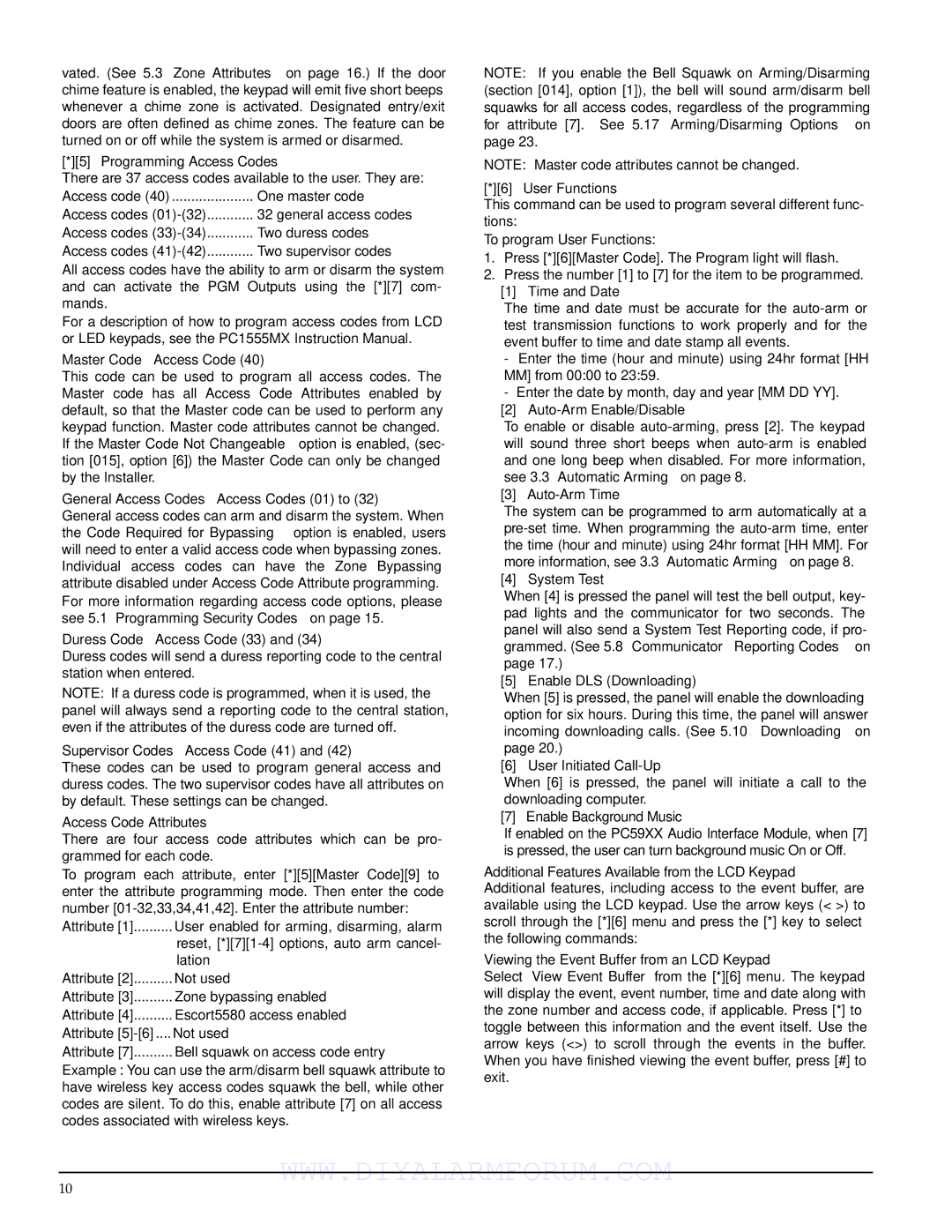vated. (See 5.3 “Zone Attributes” on page 16.) If the door chime feature is enabled, the keypad will emit five short beeps whenever a chime zone is activated. Designated entry/exit doors are often defined as chime zones. The feature can be turned on or off while the system is armed or disarmed.
[*][5] Programming Access Codes
There are 37 access codes available to the user. They are:
Access code (40) | One master code |
Access codes (01)-(32) | 32 general access codes |
Access codes (33)-(34) | Two duress codes |
Access codes (41)-(42) | Two supervisor codes |
All access codes have the ability to arm or disarm the system and can activate the PGM Outputs using the [*][7] com- mands.
For a description of how to program access codes from LCD or LED keypads, see the PC1555MX Instruction Manual.
Master Code – Access Code (40)
This code can be used to program all access codes. The Master code has all Access Code Attributes enabled by default, so that the Master code can be used to perform any keypad function. Master code attributes cannot be changed. If the Master Code Not Changeable option is enabled, (sec- tion [015], option [6]) the Master Code can only be changed by the Installer.
General Access Codes – Access Codes (01) to (32) General access codes can arm and disarm the system. When the Code Required for Bypassing option is enabled, users will need to enter a valid access code when bypassing zones. Individual access codes can have the Zone Bypassing attribute disabled under Access Code Attribute programming. For more information regarding access code options, please see 5.1 “Programming Security Codes” on page 15.
Duress Code – Access Code (33) and (34)
Duress codes will send a duress reporting code to the central station when entered.
NOTE: If a duress code is programmed, when it is used, the panel will always send a reporting code to the central station, even if the attributes of the duress code are turned off.
Supervisor Codes – Access Code (41) and (42)
These codes can be used to program general access and duress codes. The two supervisor codes have all attributes on by default. These settings can be changed.
Access Code Attributes
There are four access code attributes which can be pro- grammed for each code.
To program each attribute, enter [*][5][Master Code][9] to enter the attribute programming mode. Then enter the code number [01-32,33,34,41,42]. Enter the attribute number:
Attribute [1] | User enabled for arming, disarming, alarm |
| reset, [*][7][1-4] options, auto arm cancel- |
| lation |
Attribute [2] | Not used |
Attribute [3] | Zone bypassing enabled |
Attribute [4] | Escort5580 access enabled |
Attribute [5]-[6] .... | Not used |
Attribute [7] | Bell squawk on access code entry |
Example: You can use the arm/disarm bell squawk attribute to have wireless key access codes squawk the bell, while other codes are silent. To do this, enable attribute [7] on all access codes associated with wireless keys.
NOTE: If you enable the Bell Squawk on Arming/Disarming (section [014], option [1]), the bell will sound arm/disarm bell squawks for all access codes, regardless of the programming for attribute [7]. See 5.17 “Arming/Disarming Options” on page 23.
NOTE: Master code attributes cannot be changed.
[*][6] User Functions
This command can be used to program several different func- tions:
To program User Functions:
1.Press [*][6][Master Code]. The Program light will flash.
2.Press the number [1] to [7] for the item to be programmed.
• [1] – Time and Date
The time and date must be accurate for the auto-arm or test transmission functions to work properly and for the event buffer to time and date stamp all events.
-Enter the time (hour and minute) using 24hr format [HH MM] from 00:00 to 23:59.
-Enter the date by month, day and year [MM DD YY].
•[2] – Auto-Arm Enable/Disable
To enable or disable auto-arming, press [2]. The keypad will sound three short beeps when auto-arm is enabled and one long beep when disabled. For more information, see 3.3 “Automatic Arming” on page 8.
•[3] – Auto-Arm Time
The system can be programmed to arm automatically at a pre-set time. When programming the auto-arm time, enter the time (hour and minute) using 24hr format [HH MM]. For more information, see 3.3 “Automatic Arming” on page 8.
•[4] – System Test
When [4] is pressed the panel will test the bell output, key- pad lights and the communicator for two seconds. The panel will also send a System Test Reporting code, if pro- grammed. (See 5.8 “Communicator – Reporting Codes” on page 17.)
•[5] – Enable DLS (Downloading)
When [5] is pressed, the panel will enable the downloading option for six hours. During this time, the panel will answer incoming downloading calls. (See 5.10 “Downloading” on page 20.)
•[6] – User Initiated Call-Up
When [6] is pressed, the panel will initiate a call to the downloading computer.
•[7] – Enable Background Music
If enabled on the PC59XX Audio Interface Module, when [7] is pressed, the user can turn background music On or Off.
Additional Features Available from the LCD Keypad Additional features, including access to the event buffer, are available using the LCD keypad. Use the arrow keys (< >) to scroll through the [*][6] menu and press the [*] key to select the following commands:
Viewing the Event Buffer from an LCD Keypad
Select “View Event Buffer” from the [*][6] menu. The keypad will display the event, event number, time and date along with the zone number and access code, if applicable. Press [*] to toggle between this information and the event itself. Use the arrow keys (<>) to scroll through the events in the buffer. When you have finished viewing the event buffer, press [#] to exit.
